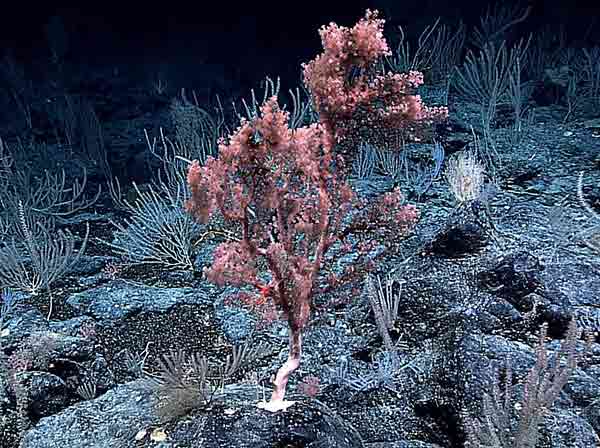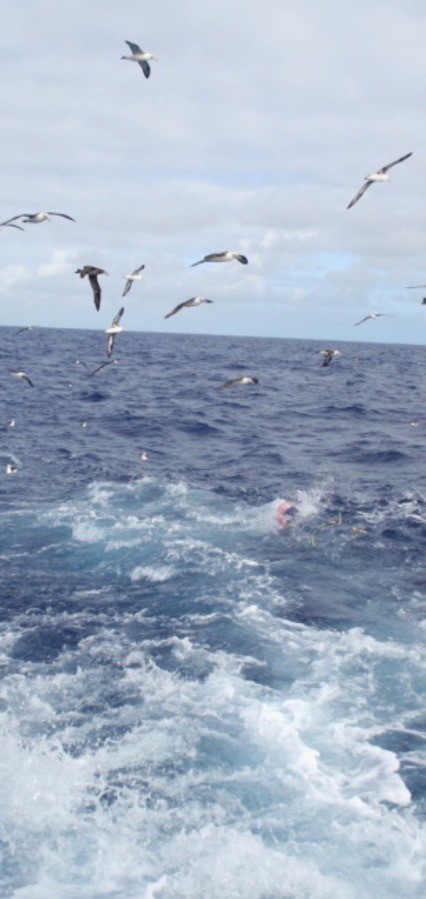The debate over the proposed expansion of the Papahanaumokuakea Marine National Monument has so far focused mainly on potential impacts to Hawai`i’s longline fishery. But at last month’s meeting of the Northwestern Hawaiian Islands Ecosystem Reserve Advisory Council, William Aila reminded the council, “It’s not only about fishing. It’s about sea bed mining, protecting maritime cultural resources of the Midway battle, Hawaiian cultural resources … the birds, fish, winds, cloud and rain.” Aila is one of the several native Hawaiians who earlier this year wrote President Barack Obama seeking greater protections for federal waters in the Northwestern Hawaiian Islands (NWHI).
‘No Recovery, Ever’
A “prime crust zone” spans a large swath of the sea floor in the NWHI, monument research specialist Daniel Wagner reported at the council’s May meeting. And in that crust, he said, are commercially valuable manganese, copper, zinc, cobalt and titanium.
The sea floor is increasingly being prospected by the mining industry, he told the council. “Some areas are protected. Most are going to be explored,” he said. While most of that exploration so far has taken place in international waters, he’s convinced that deep-sea mining in U.S. waters is something that “probably will happen in my lifetime.”
Any mining in U.S. waters would have to clear the approval process overseen by the National Oceanic and Atmospheric Administration, itself a division of the Department of Commerce. Should mining ever occur in the NWHI, some have suggested that it would devastate the rich biological communities that Wagner and other researchers have discovered during recent research cruises.
In more than two dozen unmanned, deep-sea submersible dives done in the NWHI in the past two years — six of them in the expansion area — researchers found high-density biological communities “in almost every place we looked,” Wagner said. Not only did the submersibles find the much-publicized “ghost” octopus (likely a new species), the world’s oldest living marine organism (a 4,000-plus-year-old black coral), and the world’s largest sponge, Wagner said they also discovered the largest known marine community, spanning more than ten miles.
“At these depths, we don’t just have new species, we have remarkable new species,” he said. And the sea floor teems with so much life, he added, that there were times when the submersible operators couldn’t land the rover.
“It had to hover,” he said.

While most of the dives were done inside the monument, Wagner noted that all the seamounts in the NWHI EEZ likely have high-density biological communities. One seamount recently discovered peaked within 100 meters of the surface, while others were as tall as Mauna Kea (nearly 14,000 feet from sea level to summit) and the island of O`ahu, he said.
University of Hawai`i Fisheries Ecology Research Lab director Alan Friedlander told Environment Hawai`i that the NWHI may not have particularly rich manganese deposits, but its seamount peaks do have crusts of cobalt, an element used in electronics and computers. “You can imagine lopping off the top of these seamounts … There will be no recovery, ever,” he said.
Expansion of the monument would protect approximately 110 additional seamounts from the effects of deep sea mining, according to a white paper issued last month by the grassroots group Expand Papahanaumokuakea.
‘Collateral Damage’
In addition to protecting deep-water habitats, proponents of the expansion hope to reduce the Hawai`i longline fleet’s bycatch. Seabirds, turtles, marine mammals, and other species are “collateral damage” in the longline fishery, Friedlander said. In 2014, the fishery interacted with dozens of Black-footed and Laysan albatross in federal waters around the NWHI, and between 2009 and 2014, federal fishery observers documented two takes of endangered false killer whales there, according to NOAA maps. The fishery also catches and releases several thousand sharks of various species in the region annually. With an expanded monument, “those species will be afforded protection,” Friedlander claims.

Opponents, however, argue that the fishery is not jeopardizing any incidentally incidentally caught species. Western Pacific Fishery Management Council staffer Eric Kingma said at last month’s council meeting that 85 percent of the sharks caught are blue sharks, which, he argued, are not vulnerable to over-exploitation (this despite the fact that they are considered “near threatened” by the International Union for Conservation of Nature). Kingma added that the Hawai`i longline fishery is a model for effective seabird bycatch mitigation. “The way you protect seabirds is have other fleets adopt Hawai’i’s practices,” he said. (It should be noted, however, that litigation related to the fishery’s take of seabirds and endangered sea turtles is ongoing.)
The extent of bycatch impacts aside, expansion proponents have argued for the preservation of all NWHI resources in their natural state. Alia told the council that native Hawaiians consider natural and cultural resources to be one and the same. What’s more, the white paper states, the Hawaiian cultural practices of voyaging and wayfinding rely on biological signs, including the presence of marine life and birds. It adds that with the increase in the number of traditional Hawaiian voyaging canoes, the ocean surrounding the NWHI is a “critical training ground” for navigators.
— Teresa Dawson
Volume 27, Number 1 July 2016



Leave a Reply